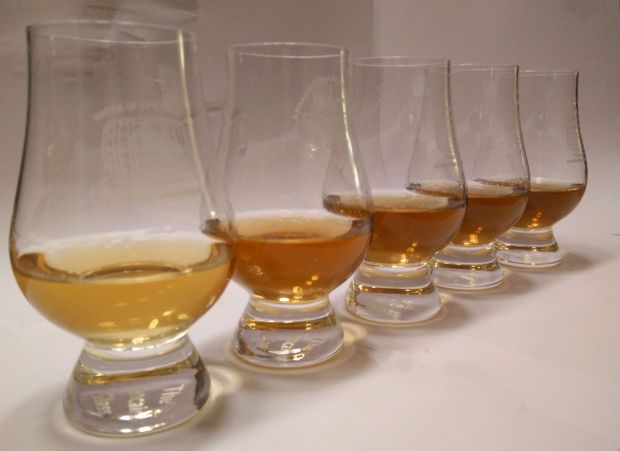For the first batch, Master of Malt recommends to fill your cask with something other than expensive whisky. This is because the cask has never been used before, and the wood is still packed full of flavours that are ready to overwhelm any liquid you place inside it. For this purpose, I decided to use Bols Corenwyn, as this resembles unaged whisky spirit fairly closely.

The first batch uses Bols Corenwyn
Korenwijn (Bols uses the Corenwyn spelling to make their product seem that little bit more fancy) is a type of Dutch jenever. It literally translates to ‘grain wine’, and to an extent it is just that. By regulation, korenwijn must contain at least 51% malt wine, meaning that like a whisky, malted barley is its main ingredient. To contrast, ‘jonge’ jenever may contain no more than 15% malt wine, while ‘oude’ jenever must have at least 15%. As such, korenwijn is often seen as the more luxurious cousin of jenever, and indeed is often cask-aged before being bottled. Korenwijn is distilled to a strength of about 50% alcohol and bottled at a standard 38%. Distillation to such a low alcohol percentage leaves a lot of space for impurities, and these are traditionally masked by the addition of herbs. The botanical of choice is typically juniper, from which the name jenever derives.
Anyway, enough about the background, let’s move onto maturing the stuff. I filled the cask with 1175ml of Corenwyn, and placed it in my shed in the hopes that lower temperatures would lead to less evaporation. I can’t be sure whether it helped or not, as I lost about 25ml to evaporation each week either way. This equates to an angel’s share of about 2% per week. Comparing this to 1-2% per year for a typical whisky distillery, this may seem like a lot. Yet because the size of the cask is so small, there is a lot of contact between wood and liquid, which leads to much quicker maturation. For a finish like this, an additional maturation of a month seems more than enough, and overall evaporation will be around 8-9%.
I took out a 50ml sample at the end of each week, and decided to empty the cask after one month. As you can see in the picture, the korenwijn clearly changed colour over time, as the wood imparted its flavours to the liquid.

On the left is the original korenwijn, with each subsequent glass having received an extra week of maturation.

The difference in colour is clearly visible, with the oldest liquid being the darkest.
In terms of flavour, the effects of the additional maturation were clearly noticeable. Even after spending just one week in the cask, the wood had taken some of the rough, acrid edges off the korenwijn. Over time, the flavour of toasted wood became more and more apparent, and the liquid had a much fuller and more complex character. While the taste of the botanicals was strong in the original korenwijn and after one week, the woody vanilla flavour became more dominant from week 2 onwards. In fact, by week 4, the influence of the cask is quite overpowering, and the liquid has become rather one-dimensional. The end result is slightly bitter, and admittedly the korenwijn tasted better after spending three weeks in the cask rather than four. This shows that there is such a thing as too much maturation, and explains why whisky makers bottle their whiskies at different age statements. Particularly for a virgin oak cask, the impact of the wood can quickly become overpowering if left too long. This is one of the reasons virgin oak is rarely used in the Scottish whisky industry.
Having said that, my end result is still a marked improvement over the original korenwijn. Although the maturation period was only a month, it makes a world of difference in terms of flavour, and clearly shows the power of wood in transforming an average liquid into something far more special.

The original on the left, with the end result on the right.
Although the cask is now ready for the first batch of whisky, I have decided to first fill it with port, so the wood may take on some of the port’s flavours. After this I will fill it with Ardbeg 10 years old, to create my very own Ardbeg Port Finish. More on that in next month’s post!

Ready for the next batch: Ardbeg Port Finish!
Interested to try it out for yourself? You can buy the cask here at Master of Malt.
This is such an interesting experiment. I can’t say I know too much about the Korenwijn, but the photos really tell the full story! The colour difference is amazing! And I find it very interesting that the week three version was better than the week four one. Good luck with the ardbeg aging – I’m hugely curious as to the results!
Keep on waffling,
Nick
LikeLike
P.S. How did you measure the amount of evaporation each week? Did you empty the barrel and measure before refilling? Or was it weight thing? Or something completely different?
Keep on waffling,
Nick
LikeLike
Thanks Nick! It’s actually a huge amount of fun to be trying this, and I’m very excited about the Ardbeg. I’ve had a small preliminary sip and it promises good things!
I did empty and refill the cask every week for the first batch so I could calculate the evaporation. It was just to get an idea of what to expect, from now on I’ll leave the whisky in the cask where it belongs. Apart from taking the occasional sip of course, purely for scientific reasons… 😉
Slàinte,
Laurens
LikeLike